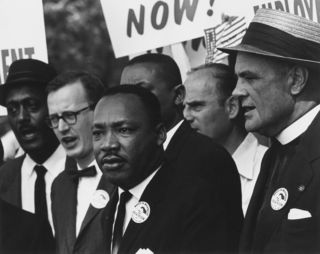Anger
Hardwired to Hate?
Lessons from Dr. King and neurobiology.
Posted January 20, 2020 Reviewed by Lybi Ma
"I have decided to stick with love. Hate is too great a burden to bear."
—Dr. Martin Luther King, Jr.

What Is Hate and How Does It Manifest In the Brain?
Hate is difficult to define, with little research having been done on the subject directly. Whatever the definition, it is clearly a complex phenomenon composed of equal parts anger, fear, and ignorance.
Hatred often takes the form of discrimination, aggression, and violence based on such characteristics as race, gender, sexual orientation, religion or ethnicity. What we understand as hate seems to have roots in the deepest, most primitive centers of our brains. Studies on hatred specifically have been limited, but the associated components of fear, anxiety, empathy (and lack thereof), pain and the processing of sensory stimuli have been shown to activate deep brain regions like the amygdala, hypothalamus, insular cortex, and the periaqueductal grey.
Ultimately, these brain structures serve to activate our sympathetic nervous system, stimulating our "fight-or-flight" response instantly and unconsciously in response to a perceived threat. Thankfully, our response doesn't stop there. Higher-level brain structures, such as the ventromedial prefrontal cortex (vmPFC), then enable us to choose our response by considering the potential consequences. We have a choice whether to act on our primitive drives, no matter how strong they may feel.
While the impact on others is obvious, we often fail to consider the impact of hate on ourselves. When we harbor hatred, our threat response system remains activated, keeping us in a chronic state of sympathetic overdrive. This keeps our heart rate and blood pressure high and the immune system remains constantly poised for attack. Over time, these changes increase our risk of heart disease, stroke, diabetes, depression, and a host of other illnesses.
How Do We Let Go of Hate?
Knowing the negative consequences for ourselves and others, how do we overcome hatred? Dr. King proposed understanding as the antidote to hate, stating:
“People fail to get along because they fear each other; they fear each other because they don't know each other; they don't know each other because they have not communicated with each other.”
Dr. King knew that it is difficult to hate someone we truly know. When we come close to someone and learn about their struggles, we begin to see them as more like us. We start to see their humanity.
And what if understanding fails us? What if we cannot understand, or what if we still feel anger despite understanding? In these cases, we must make the choice to let go. Dr. King remarked:
"Nonviolence means avoiding not only external physical violence but also internal violence of spirit. You not only refuse to shoot a man, but you refuse to hate him.”
You have the choice to refuse hate. But how is this possible if the drive to hate is located in a primitive and unconscious part of the brain? This is where the higher-order brain structures, like the vmPFC and others, give us the freedom to choose whether to engage our anger and hatred or let it go. And while activity in the primitive brain structures modulating fear and anger may ebb and flow with time, these more advanced parts of our brain provide constant oversight.
Deciding to embrace love over hate is an active process, and we are never really finished. Instead, we decide over and over again, moment by moment, to let go of our anger and fear and instead find relief, strength, and freedom in unconditional love. As we celebrate Dr. King's legacy today, his words give us hope that we can succeed:
“I believe that unarmed truth and unconditional love will have the final word in reality. This is why right, temporarily defeated, is stronger than evil triumphant.”
References
Blair, R. J. R. (2016). The neurobiology of impulsive aggression. Journal of Child and Adolescent Psychopharmacology, 26, 4-9.
Sapolsky, R. (2017). Behave: The biology of humans at our best and worst. New York, NY: Penguin Press.
Deng, H., Xiao, X., & Wang, Z. (2016). Periaqueductal Gray neuronal activities underlie different aspects of defensive behaviors. J Neurosci, 36, 7580–8.
Zeki, S., & Romaya, J.P. (2008). Neural correlates of hate. PLoS ONE, 3, e3556.


